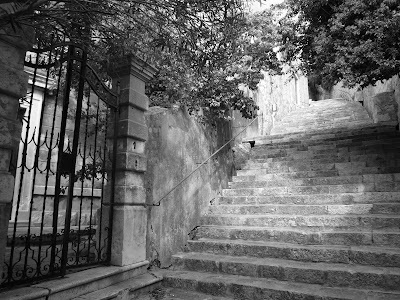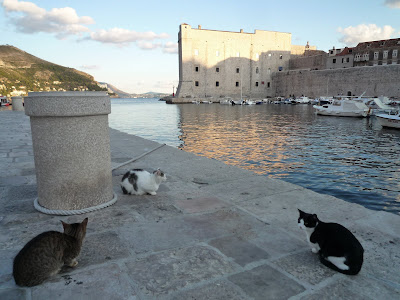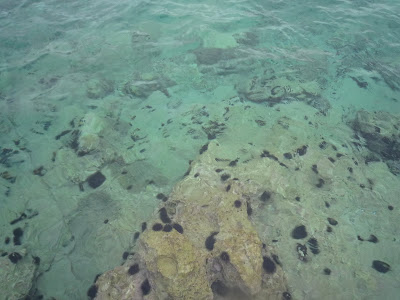From last Friday to Tuesday I found myself, for the first time, in the Belgian capital city, enjoying the sights and the food. After arriving I met my French friend Julie in the train station, where Julie's friend, Emily, greeted us. We would stay with Emily at her apartment and with her two roommates for the next four nights.
When most people think of Belgium they can instantly find connections with chocolate and waffles, but beyond these things general knowledge of this small Western European country remains lacking. Located between France and the Netherlands, the Belgian nation of roughly 11,000,000 citizens is essentially two cultures living together. The southern half of the country is known as Wallonia, home to the French-influenced and French-speaking Walloons. Flanders consists of the larger northern half and the Flems, who speak a dialect of Dutch called Flemish. The national capital, Brussels, rests in the southern portion of Flanders. The city is the only officially bilingual region of the country, but French is actually the primary language in Brussels. In contradiction to this, the Flems constitute the majority of the Belgian population.
As most people's initial thoughts of chocolate and waffles would hint, Belgium has a strong food culture offering several specialties, but there is of course more to the country. For example, Waterloo, where Napoleon was defeated, lies outside the capital. More to the present, several European Union institutions and agencies have their main offices in Brussels, making the city and region of one million residents the unofficial "capital of Europe."
The apartment of Emily, who is in the city temporarily to conduct an internship in the offices of the European Union, was in the allegedly posh neighborhood of Brussels located south of its center. The neighborhood was also younger than the city center, though judging by the buildings this distinction was clearly in the relative sense. The following several photos show views from in and around Emily's neighborhood. The first one is looking out the window of Emily's apartment building. In the second you can see an example of Brussels' strong sidewalk cafe scene.




Most of Brussels' main sights are located in the city center, a masonry wedding cake with layers of architectural styles. At the very center lies the Grand Place, a medieval public square framed with early 17th century guild halls and Brussels' Gothic city hall. When a French army bombarded the city in 1695 most of the buildings around the Grand Place were leveled; the city hall remained standing with relatively less damage, an ironic outcome considering that this building was actually the French's intended target. A couple photographs of the Grand Place follow, but the city hall is not seen in either.


Branching out from the Grand Place are several narrow lanes and twisting streets. Open air markets selling goods and antiques abound, as do the pedestrians strolling from the stalls on the streets to the shops along them. In the picture below you can see Emily and Julie walking past the art galleries lining this alley.

In short walking distance from the Grand Place are two more of Brussels' most popular attractions, both seen below. The first picture shows the internationally recognized statue titled the Manneken Pis. This bronze depiction of a urinating boy is only about a foot tall, but the fountain's edge is usually crowded with camera-toting tourists. Slightly north of the Grand Place can one find the landmark seen in the second image, the Galeries St Hubert. This shopping arcade was built in the mid-18oos and still houses some of Brussels' up-scale stores.


As said earlier, Brussels and Belgium are both well known for their food offerings. Here are some looks at the foods we tried during our visit.
As an appetizer for one lunch I ordered the escargot, though as a dish I had eaten several times before it was selected more for its taste than its novelty. Of course, in the end, prepared snails are associated more with French cuisine than Belgian.

The main course that followed however was as traditionally Belgian as possible.
Moules frites consists simply of steamed mussels in a white wine sauce and French fries, and can be regarded as the national dish of Belgium. An image of the meal is seen below. Emily explained that the proper way to eat the mussels is to use one emptied mussel shell as a utensil to pull out the meat from another shell. Additionally, as one would in do in most European restaurants anyway, the French fries should be brought to one's mouth with a fork. We agreed that it was a simple, yet tasty meal.

When it comes to Beglian cuisine, most people would likely call to mind sweet concoctions before meals of mussels, and rightfully so. Belgium is the birthplace of chocolate pralines; Belgian chocolate in general requires no introduction. In Brussels, the city's main chocolatiers operate multiple stores near the main shopping and tourist destinations. The stores emit a refined ambiance. Associates, for example, wear white gloves when picking up the chocolates. One of these chocolatiers is Neuhaus, which was established in 1857 and is allegedly where the chocolate praline (chocolates with a flavored filling) was invented. Neuhaus' flagship store in Brussels, pictured below, is located in Galleries St Hubert. From here we purchased a small sampling of their pralines, including such flavors as caramel, rasberry, and champagne. All met my approval.

And who could forget Belgian waffles? There actually is not one type of Belgian waffle, rather local varieties that differ from regions and cities in Belgium. That said, the two most popular versions are those of Brussels and Liege. The waffle of Liege, a city in eastern Belgium, is made from a rich batter that contains small chunks of sugar, which essentially gurantee that every bite will be sweet and crunchy. Liege waffles are commonly sold from street vendors and in bakeries, and eatten plain.

The Brussels waffle is the kind that most Americans are likely more familiar with. Served mostly as a dessert, this version uses a yeast batter lacking the sugar chunks. Multiple toppings, such as whipped cream, fruits, sauces, or ice cream, are placed on the warm waffle. Savory versions also exist, but are ordered less commonly. One of the incredibly sweet Brussels waffle that I tried is the subject of the following photograph. Indeed, under the strawberries, chocolate sauce, powdered sugar, and two types of ice cream is a waffle. After trying both the Brussels and Liege waffles, I decided that my preference lies with the latter, which was evidenced by the fact that I ate at least three a day.

From waffles we arrive at the last Belgian culinary specialty that I will take time to exhibit: the French fry. Though the reason for the misconception remains uncertain, perhaps it deals somehow with the fact that part of Belgium speaks French, the truth is that French fries are traditionally Belgian, not French. Belgians proudly claim that their small country is the home of this now world-wide side dish, and they demonstrate it by accompanying many meals with the fried-potato slices. This may inevitably lead one to ask what the Belgians call French fries. The answer would be the same names that the French use,
pommes frites or, simply,
frites. These are the French words for, respectively, fried potatoes and fried (Technically the French name for potato is
pomme de terre, apple of the Earth). Whatever the origin, the Belgians do indeed offer some quality French fries.
Emily brought use to a street vendor that was a fifteen-minute walk from her apartment. After asking around during her first weeks in Brussels, she had learned that the title for the best Fench fries in the city usully goes to either this vendor or another north of the city center. The line of customers in the first photo attests to the popularity of this stand and its fries. After waiting at least ten minutes to place our order, we waited a little longer for the cook to prepare the fries fresh. Clearly, no bags were being pulled from a freezer. You can see the final crispy product in the second following picture.
Considering that I've had an incountable number of portion of French fries in my lifetime, I probably can't say with certainity that they were the best I've had, though I am tempted to do so, but I can definitely report that they were the best from recent memory. The golden slivers of potatoes were consistently firm, yet never over-fried. Not one came close to being soggy, and traces of oil didn't exist. The salty seasoning was light enough that it didn't overpower the taste of the potato or cause one to reach for his drink. Though quite a number of dipping sauces were offered on the side, I chose the Belgian favorite of mayonnaise. The pairing is recommended.


The European Quarter north of the city center, where several of the European Union offices are located, is likely less of a destination in Brussels for most tourists (espeically those outside of Europe), but ranked as my favorite experience in the city. Europe is in the midst of a great democratic experiment, and this experiment is known as the European Union.
The E.U. is a unique, original goverment body that is changing the face of Europe. Unlike the United Nations, the E.U. is not merely a stage for international cooperation or a collection of government representatives to discuss common issues. Likewise, the E.U. is not a federation like the United States of America because its independent member states retain levels of sovereignty in multiple areas. In other areas where the member states have decided that a regional approach is better, such as trade and environmental protection, they have pooled their sovereignty together to create European law. For simplicity's sake, it may help to think of the E.U. as a confederation of European nations. An additional result is that member states are able to have greater world influence together than they would alone. But the E.U. is not simply an invisible bureaucracy, as it has grown stronger, its presence has been seen and felt more and more across the continent.
What started as the European Coal and Steel Community in 1952 with six member states, has become the European Union of 27 members. As the name accurately describes, the E.U. has worked hard to unify Europe. Bridges, highways, high-speed rail lines, and tunnels have been built and funded to better connect member states. The euro was introduced as a common currency to additionally facilitate trade, and is used by most member states. Every five years an election throughout the E.U. takes places for its 500 million citizens to choose their representatives in the European Parliament. The E.U. has a flag (twelve blue stars on a blue background) and an official anthem (
Ode to Joy, based on Beethoven's
Ninth Symphony). It would be inaccurate to label the E.U. as a country, but with integration continuing and pushes for the E.U. government to hold greater power strengthing, that may one day in the far future be more of the case.
In many senses, the E.U. now is similar to the U.S.A. in its beginnings. For several decades even after the first goverment of America failed, the Articles of Confederation, member states held greater power than today and fought for "states' rights." Residents of the states described themselves as citizens of their respecitve states first, then as Americans, partly because American citizenship didn't officially exist until after the Civil War. As time passed, the states united physically and emotionally. The parallels with the E.U. exist, and because of this, at least for me anyway, the evolution and shaping of the E.U. is interesting and entertaining to follow.
Due to reasons too complicated to discuss here, many of the E.U. law-making institutions and supporting agencies have their main offices in Brussels. The photograph below shows one building in the European Quarter, the walls of which are labeled with public messages reminding people to vote in the recent elections for the European Parliament.

The main sight to be seen in the European Quarter is the European Parliament. This is actually one of two locations where the parliament meets. The other seat is in Strasbourg, France, and the reason for this is, again, too complicated for this post. Free tours are held inside the parliament building to allow European citizens to see the meeting chamber and better understand how the body works. In the first picture below is a sign on the parliament building indicating what it is in each of the E.U.'s 23 official languages. The second photo shows a larger perspective of the building.


On the tour, I learned many interesting things, but most fascinating for me were the details involving the language interpreters. On the front circular wall of the meeting chamber, seen below, are rooms for the interpreters who represent each of the 23 E.U. languages. As there is a room for each language and there are three interpreters in each room, at any moment during a parliament meeting there 69 interpreters listening to the discussion. Each interpreter can speak four foreign languages fluently, meaning that each language room has the capacity to translate only twelve languages, which clearly isn't enough. To solve this problem, whenever a more seldom language is spoken, like Estonian, it is first translated byan interpreter of a far more common language, like English, and then the interpreters of the other languages use the English version. In this manner a double translation of the speaker's words takes place.
Because a parliament session lasts from nine o'clock in the morning until midnight, the interpreters work in several shifts. The result is that nearly 600 interpreters are needed for one parliament session. Due to this high number, parliament sessions must be planned with consideration for the meetings of United Nations' General Assembly, which uses slightly more languages than the E.U. A meeting of both bodies can not take place simultaneously, otherwise there would not be enough qualified interpreters in the whole world to attend both.
The time limit for how long a representative can address the parliament ranges from one to two minutes, depending on the circumstances. When the allotted time expires, the representative is warned, if he continues to speak the microphone is turned off. In most national parliaments this would do little good, as the speaker could simply raise his voice and continue to hold the floor. In the European Parliament though the time limits are rarely exceeded. Once the microphone is turned off the interpreters can no longer hear the speaker, and, as such, no longer translate. If a representative were to continue past the time limit, most of his audience simply wouldn't understand him.

One last major sight for Brussels, and a landmark for all of Belgium, is the Atomium. This bizarre structure resembling a giant model set from chemistry class is pictured in the last image. Inside the Atomium is a restaurant, exhibition space, and a viewing deck. As a remnant of the 1958 World's Fair in Brussels, the landmark today is an attraction for tourists and visitors to the city. Apparently, some of the spheres are currently closed due to safety concerns.

On Tuesday we left Brussels, and I returned to Germany for my last week before leaving for my visit home. Though it may not receive as much attention as the other capital cities of Europe, Brussels should not be forgotten or overlooked. Many new experiences await one with a visit to the so-called "capital of Europe."





























































